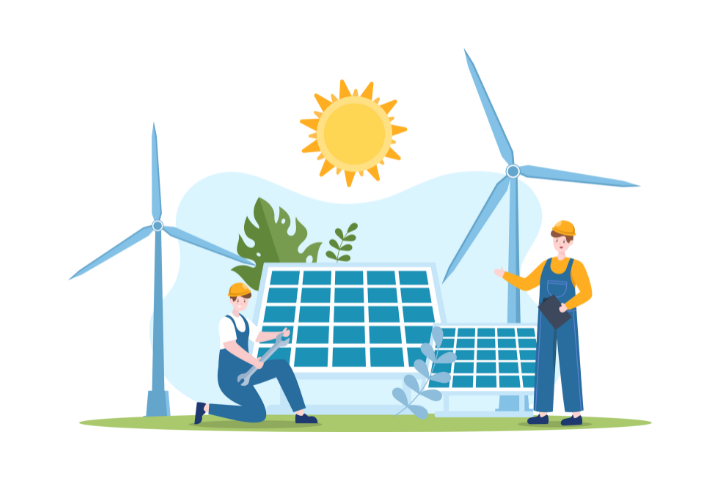
A brief background and need
The 2015 Paris Agreement recognized the idea of a “Just Transition”—a concept that has become central to how countries think about moving toward a low-carbon, sustainable future. At its core, the Just Transition means making sure this shift away from carbon-heavy energy sources to greener alternatives is fair and inclusive. It is about supporting people who might lose out in the process, like workers in the fossil fuel sector, communities that depend on these sectors, and low-income households that could be negatively affected if climate policies lack a socially responsible framework.1
Across the world, conversation around Just Transition is gaining momentum as governments and international organizations are beginning to act on it. For example, the World Bank’s “Just Transition for All” initiative focuses on putting people and communities first, offering targeted support to reduce potential negative effects.2 Likewise, during COP26 in Glasgow in 2021, the “Just Transition Declaration” was launched3, highlighting the importance of pursuing low-carbon economies through an inclusive and fair approach that protects workers and other vulnerable groups.
Many countries are now shaping their approaches.
- South Africa formed a Presidential Climate Commission and created a national Just Transition Framework to steer policy and investment choices toward a sustainable future.4
- Canada introduced its Sustainable Jobs Plan5, aiming to support workers in the transition to green industries.
- Poland is phasing out coal while involving local communities to avoid major social or economic disruption.6
- Morocco reformed its fuel subsidies to protect low-income groups while staying on track with climate goals.7
These efforts underscore the increasing awareness that moving toward a cleaner economy should not only prioritize environmental sustainability but also ensure social fairness.
India’s Just Transition Journey India’s interest in just transition is growing too, as the country’s fast-paced economic growth relies heavily on accessible and reliable energy. Despite having per capita CO₂ emissions lower than the global average, India is the third-largest emitter globally and has a large population at risk from the impacts of climate change. Although the Indian government has outlined bold goals for expanding renewable energy, moving away from coal—which currently provides 45% of the country’s primary energy—poses significant challenges due to regional imbalances in resource distribution. While fossil fuel reserves are primarily located in central and eastern states, the greatest potential for renewable energy lies in the western parts of the country. This geographic mismatch creates disparities in both energy resources and investments. As a result, the transition to cleaner energy sources could have a disproportionate effect on coal-dependent eastern states, potentially triggering widespread job-related migration unless efforts are made to retrain workers and create green employment opportunities.8 This has prompted major coal-producing states like Odisha, Jharkhand, and Chhattisgarh—which together account for around 60% of India’s coal production—to actively engage in the discourse on Just Transition. Notably, Jharkhand has taken a formal step by establishing a “Sustainable Just Transition Taskforce,” drafting a vision document, and identifying eight thematic areas to guide the state’s shift from a fossil fuel-dependent economy to a cleaner, more sustainable one.9
Challenges in Implementation
The number of jobs created in the renewable energy sector may not be enough to offset employment losses in regions that rely heavily on fossil fuels, as renewable energy typically requires fewer workers.
- Landless laborers and women are especially affected, often facing the greatest disruptions while receiving little to no compensation or support.
- Coal has historically been affordable, and it plays a significant role in subsidizing rail transport. Thus, the inconsistent nature of renewable energy supply and weak power grid infrastructure pose further challenges.
- Political commitment to Just Transition varies between state and national governments.
Nevertheless, the decline in the cost of renewable energy, growing climate concerns, and changing employment trends all signal a need for change The key will be careful planning that ensures the transition is not just green but also fair, inclusive, and truly sustainable for everyone.10
Notes
1-The opportunity for Just Transition in India | Climate Group. (n.d.). Climate Group. https://www.theclimategroup.org/our-work/news/opportunity-just-transition-india
2- Just Transition for All: The World Bank Group’s Support to Countries Transitioning Away from Coal. (n.d.). World Bank. https://www.worldbank.org/en/topic/extractiveindustries/justtransition
3- Just Transition Declaration: Can it be the way towards achieving universal access to clean cooking fuels and technologies? (n.d.). orfonline.org. https://www.orfonline.org/expert-speak/just-transition-declaration-can-it-be-the-way-towards-achieving-universal-access-to-clean-cooking-fuels-and-technologies#:~:text=Another%20aspect%20encompassing%20the%20inclusivity,clean%20cooking%20fuels%20and%20technologies.
4- Presidential Climate Commission. (n.d.). https://www.climatecommission.org.za/about
5- Canada, N. R. (2025, January 9). Sustainable Jobs Plan. Natural Resources Canada. https://natural-resources.canada.ca/corporate/planning-reporting/sustainable-jobs-plan
6- Śniegocki, A., Wasilewski, M., Zygmunt, I., Look, W., & Resources for the Future. (2022). Just Transition in Poland: A review of public policies to assist Polish coal communities in transition. In Report 22-06. https://media.rff.org/documents/Report_22-06_June_1_2022.pdf
7- Morocco: Fuel subsidy reform designed to support a just transition to renewable energy. (n.d.). World Resources Institute. https://www.wri.org/update/morocco-fuel-subsidy-reform-designed-support-just-transition-renewable-energy#:~:text=The%20Government%20of%20Morocco’s%20fossil,and%20increased%20the%20country’s%20energy
8- Modi, N. (2022). Facilitating a Transition Away from Coal in India. February. https://cuts-ccier.org/pdf/discussion-paper-enabling-just-transition-in-indias-power-generation-sector.pdf
9- Tandon, A. (2024, September 27). India’s clean energy goals may widen regional disparities, predicts working paper. Mongabay-India. https://india.mongabay.com/2023/10/indias-clean-energy-goals-may-widen-regional-disparities-predicts-working-paper/#:~:text=%E2%80%9CThe%20impact%20is%20most%20severe,%2C%E2%80%9D%20says%20the%20working%20paper.
10 Climate Investment Funds. (2021). Just transitions in India. In Climate Investment Funds. https://unfccc.int/sites/default/files/resource/Inputs%20from%20Climate%20Investment%20Funds_%20India_CIF%20Case%20Study.pdf
Author: Rishabh Kandpal, Research Associate, Development Solutions
